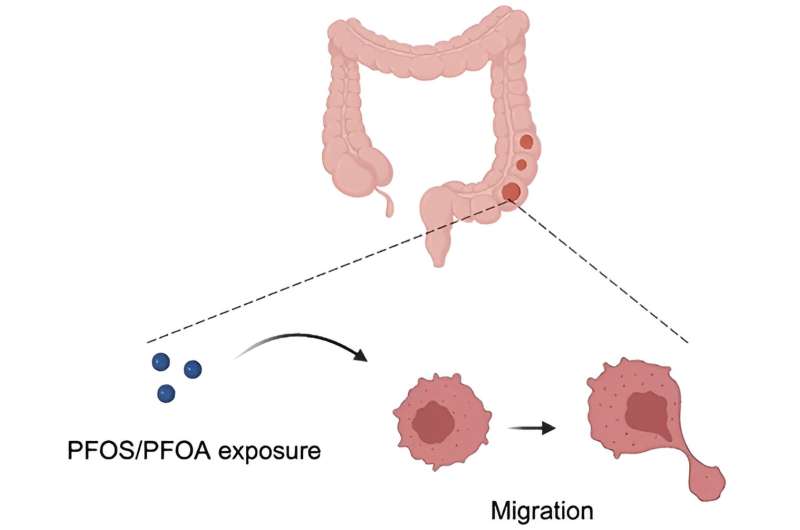This article has been reviewed according to Science X's editorial process and policies. Editors have highlighted the following attributes while ensuring the content's credibility:
fact-checked
peer-reviewed publication
trusted source
proofread
PFAS pollutants promote cancer cell migration: Study

In a new study by researchers at the Yale School of Public Health, two "forever chemicals" spurred cancer cells in the lab to migrate to new positions, an indication that the chemicals could contribute to cancer metastasis in living organisms. The research is published in the journal Environmental Science & Technology.
The study addressed the group of industrial chemicals called per- and polyfluoroalkyl substances (PFAS). The substances are known as "forever chemicals" because they don't break down in the environment and can build up in the human body. All have the ability to shed water and resist penetration by oils. They are notorious for their ubiquity, their exceptional environmental stability, and their suspected toxic effects.
"PFAS make up a prevalent class of persistent organic pollutants of increasing public concern worldwide. They have been frequently detected in the environment, such as in drinking water, indoor dust, cleaning products, and coatings," said co-first author Jie Zheng, a postdoctoral associate who was working in the lab of principal investigator Caroline Johnson, Ph.D., associate professor of epidemiology (environmental health sciences), at the time the research was conducted.
The chemicals show up in the blood of newborns, of people living in sub-Arctic Indigenous communities, in fish and mussels, even birds' eggs. No level of PFAS in the body is considered safe, and they have been linked to a litany of health problems, including cancers. In November, the International Agency for Research on Cancer (IARC) classified perfluorooctanoic acid (PFOA), a common PFAS, as carcinogenic to humans and perfluorooctanesulfonic acid (PFOS), another common PFAS, as possibly carcinogenic to humans.
No studies have addressed the relationship between PFAS and colorectal carcinoma (CRC), Zheng explained. However, firefighters experience this type of cancer at higher rates than the general population and they are heavily exposed to PFAS at work. About 80% of CRC cases are thought to be related to environmental exposure of some kind.
But what the chemicals might be doing to initiate or spur on this type of cancer has been unclear.
The Johnson lab studies CRC with metabolomics, a tool that measures fluctuating levels of thousands of small molecules like amino acids, lipids, and proteins in a biological sample.
"We look at patterns that occur within an exposed group of people or a diseased group of people, then try to generate a hypothesis as to why somebody may develop a disease or have progression of disease," Johnson said. "Metabolomics is one of the only tools where you can measure environmental exposures in the same sample as the biological effect."
In this series of experiments, the authors studied how CRC cells react to being immersed in a PFAS solution for up to seven days. They observed increased cell motility with exposure and found metabolic changes that were consistent with cancer metastasis.
Results agreed with current knowledge about CRC metabolism, spread, and prognosis, amounting to evidence that the chemicals can induce metastasis.
Cancer on the move
To investigate the metabolic profile of CRC cells after PFAS exposure, the study focused on PFOS and PFOA. Both have been used in firefighting foam and many other products.
The authors used two CRC cell types from a line called SW48. One type consisted of cells with an unmutated or "wild-type" KRAS gene; in the other, the KRAS gene carried a common mutation associated with an especially deadly type of colon tumor in women. The cells formed into tiny balls called spheroids.
The researchers found that bathing spheroids in the chemicals boosted the cells' migration ability. They showed a tendency to spread and to penetrate membranes. In another experiment, researchers grew the cells as a flat, two-dimensional layer, then drew a scratch down the middle, separating half of the cells from the other half. When they added PFAS, the cell lines grew and migrated back together again.
"It doesn't prove it's metastasis, but they have increased motility, which is a feature of metastasis," Johnson said.
Metabolomic analysis revealed the spheroids were producing a variety of fatty acids, amino acids, and signaling proteins in patterns previously linked to metastasis. Small-chain fatty acids, which can protect against tumors and inflammation, were downregulated.
A Western blot found telltale up- and down-regulation of specific signal proteins associated with metastasis during a process called the epithelial-mesenchymal transition (EMT).
For example, when exposed to either chemical at higher levels, both cell types expressed less E-cadherin, rendering them less adhesive—a key step in EMT-related metastasis. The results added to the team's confidence that the cell was behaving in vitro like a metastatic cell in the body.
Some changes suggesting metastatic potential were more pronounced in the KRAS-mutated line. That could mean that cancers with this mutation may be especially prone to spread after exposure to these chemicals.
A look at the exposome
The research is part of an ongoing quest by scientists to better understand the exposome—that is, all environmental influences upon a person from conception until death, including biological, chemical, environmental, social, and so on. Because PFAS are so widespread, almost everyone is exposed.
This study used exposure levels similar to those detected in firefighters and others in frequent contact with PFAS, such as people living near landfills, airports, military bases, or wastewater treatment plants. In future studies, the Johnson lab aims to test exposures that are lower, more like those most people face every day. They also plan to look at PFAS levels and clinical outcomes in patients with colorectal cancer.
"Many in vitro studies can't be translated into humans," Johnson said, "but I think understanding first the mechanisms of how they can actually affect cancer cell growth is important."
More information: Jie Zheng et al, Perfluorooctanesulfonic Acid and Perfluorooctanoic Acid Promote Migration of Three-Dimensional Colorectal Cancer Spheroids, Environmental Science & Technology (2023). DOI: 10.1021/acs.est.3c04844




















